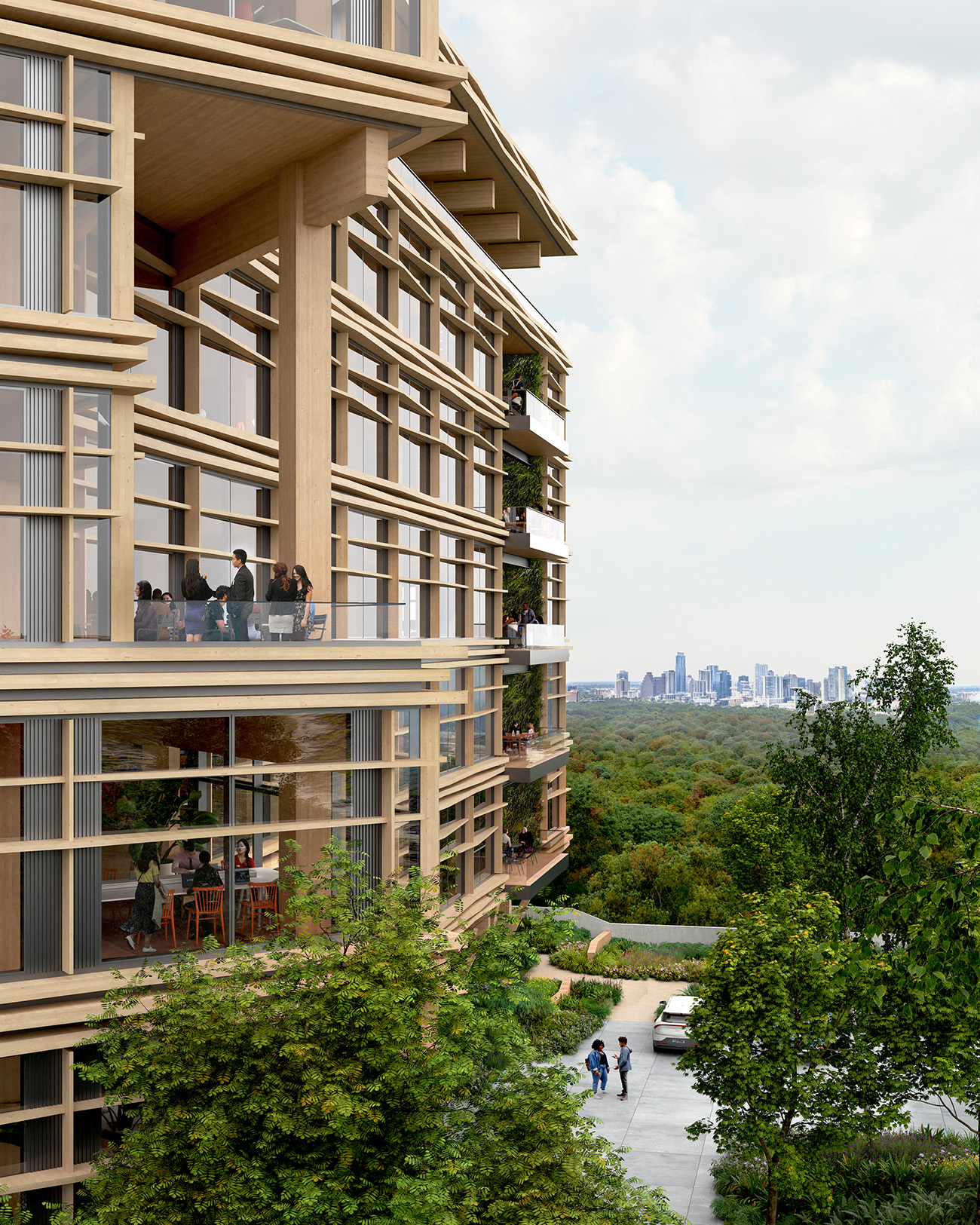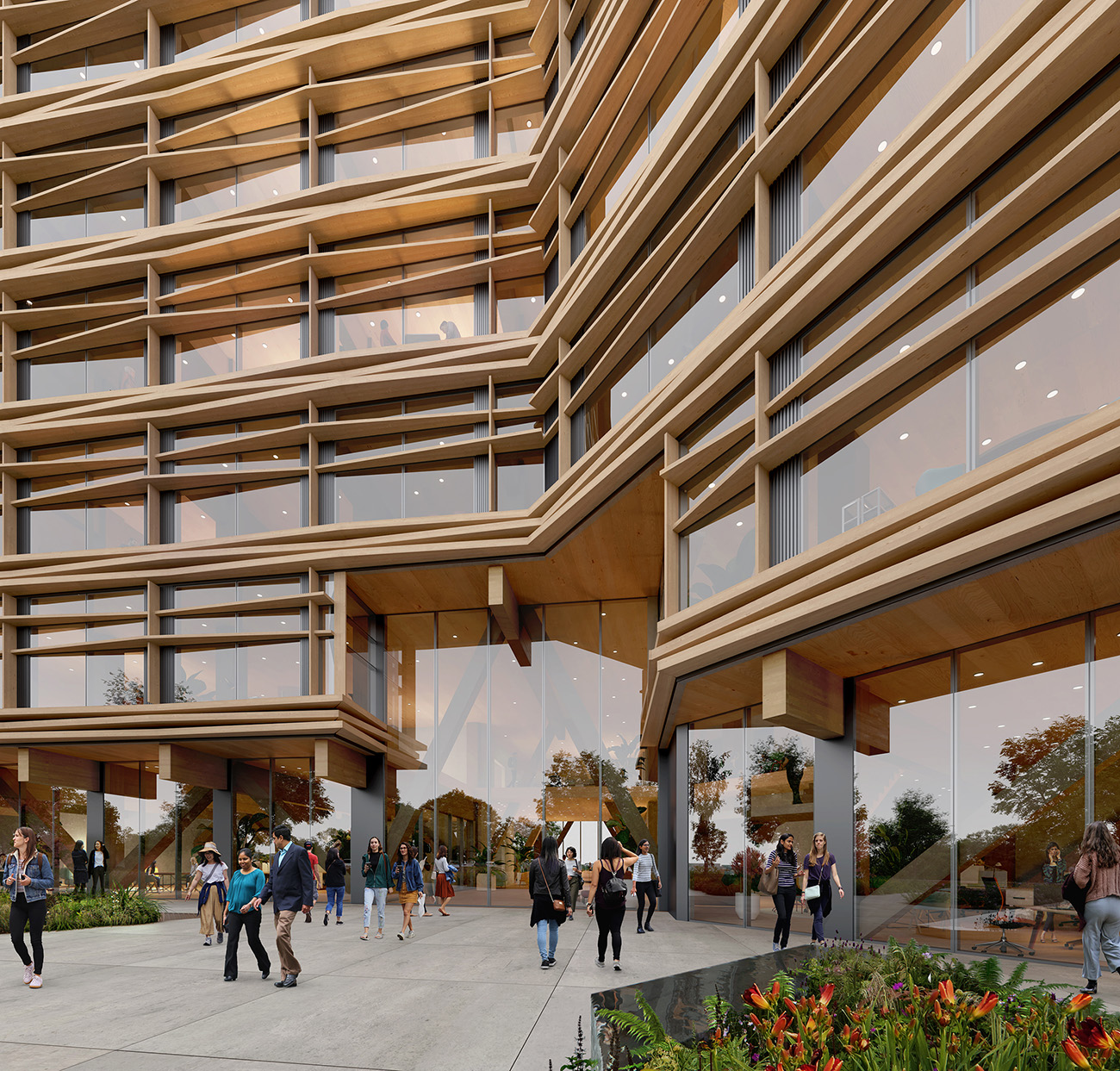Date Posted: 03.25.2024
A perfect storm catalyzed by the global pandemic, rising impacts of climate change and current financial conditions has dramatically impacted the commercial office market. With the current record-high office vacancy rate of 19.6% nationwide, developers are finding that the workplace of tomorrow is in undeniable demand today and are taking action to ensure their properties are seen as desirable to current and potential tenants.
In these conditions, speculative office projects are a sector of particular concern and opportunity. To create a unique product that would appeal to future tenants, our clients sought to explore how a typical commercial office project could be redesigned as a mass timber structure, without impacting the existing entitlement, including FAR, general building massing and below-grade parking. Our team had recently completed an innovative workplace project in one of our client’s developments, and we were brought in to employ similar thinking to reimagine this building and site.
Throughout the design exercise, the study focused on three major themes: converting the concrete structure to mass timber for improved embodied carbon performance and market appeal, advancing the health and wellness of occupants, and fostering community through shared amenities indoors and out.
STRUCTURAL SOLUTIONS FOR A SUSTAINABLE FUTURE
The most significant challenge was converting the existing cast-in-place concrete structural system to mass timber, keeping in mind that the existing massing and FAR had to be respected. Three levels of below-grade parking were already designed, utilizing a standard and economical layout. The test was to design an efficient timber grid that would transfer to the parking grid, without an expensive transfer slab. At the same time, the goal was to create a timber grid for the office floors that would allow for standard 5-ply CLT panels, while achieving the 2-hour char requirements for Type IVB construction.
Due to good soil conditions and low seismic requirements, Mithun collaborated with Fast + Epp Engineers to develop an innovative structural scheme that incorporates timber bracing to satisfy the lateral structural requirements. The bracing also serves to transfer a 15-foot one-way timber grid at the upper floors, to a 30-foot concrete grid at the parking below grade. The timber bracing is featured throughout the building, resulting in a dramatic effect that is not found in typical concrete construction.

The design positions timber not only as a structural element but also an aesthetic driver of the elegant facade, which can be enjoyed directly from a series of outdoor rooms and indirectly from adjacent roadways and regional trails.
IMPROVING PHYSICAL AND MENTAL HEALTH
It is well known that many tech companies are embracing mass timber, not only due to the embodied carbon reduction, but to elevate performance of their employees through increased creativity, stress reduction and overall mental health improvement. Combining daylight, access to nature and views, and the incorporation of natural materials such as timber and stone, results in a biophilic environment that is accessible for all employees.
Wellness has become a key consideration in the design of workspaces, and was a major focus of our re-imagining exercise. Connection to nature is known to reduce stress, optimize creativity and contribute to a sense of overall wellbeing. Utilizing the mass timber structural system, our team was able to cantilever one-way glu-lam beams at the upper floors, adding square footage to the office floors without impacting the structural grid. This extra square footage allows for the creation of “outdoor rooms” on each floor, providing every potential tenant space with direct access to nature—a valued amenity in the southwestern climate.
A unique approach to “Park-ing” reimagines the parking lot to integrate wellness-based amenities and native plantings while maintaining parking count needs based on approved entitlements. The climate and context of the building inspired this nature-based approach, providing shade and healthy opportunities to users.
The original plan included a typical parking roundabout at the main entrance and a sea of surface parking above the garage behind the building. Utilizing the existing stands of live oaks, the new design creates a careful regrade of the site to preserve as many trees as possible, with an additional plan to “re-oak” the areas needed for construction. The surface parking that serves the employee entrance was modified to incorporate bosques of trees and other vegetation, integrating the building as an inherent part of the natural environment and providing cooling shade during hot summer months. In total, approximately 50,000-square-feet of pervious cover was added to the new plan.
Reaching beyond the property boundaries, an extensive trail system nearby presented potential for an additional amenity. By adding new trail extensions at opposite ends of the site, the revised design places the building along the trail. It not only provides tenants with unimpeded access to the surrounding natural environment, but also invites regular trail users to discover and visit the new building, creating a lively thoroughfare where amenities such as a bike shop, juice bar and yoga deck with shade trellis are all envisioned.

A series of layered views and sensory experiences—from oak habitat to outdoor terraces to double-height timber atrium and beyond—create an inviting destination for employees and visitors alike.
CREATING COMMUNITY BY ELEVATING THE TENANT EXPERIENCE
The site, nestled between downtown and a beloved nature preserve, feels as though you have stepped into a tranquil retreat just minutes from the bustle of the city. Leveraging this unique condition, the building and site intertwine with ground floor programs that span inside and outside, allowing tenants to integrate nature seamlessly into their workday. Trails from the tree-lined parking and drop-off zones lead to the lobby, which features an enclosed double-story “breezeway” connecting the east and west entries. This space acts as a primary wayfinding element—housing the elevators and providing access to adjacent amenity spaces.
The lobby was imagined as a social hub for tenants and visitors alike—a place for meeting, gathering and working away from the desk, as well as a destination point for recreationalists. A coffee shop / co-working space activates the west side of the lobby and connects via feature stair to a conference center located on the mezzanine above. A shared fitness center with locker rooms, bike storage and flexible-use fitness room offers tenants an opportunity to integrate health and wellness into their workday. Outdoor porches on the east and west sides of the building extend the amenity spaces out to the site and provide covered areas to work, meet and exercise. All-gender restrooms on every floor foster inclusivity and offer easily accessible hand washing zones throughout the building.
Community-building amenities weave through every floor, starting with a shared work lounge adjacent to the elevator lobby. This lounge offers tenants an opportunity to connect, collaborate or work away from their desk with views that overlook the surrounding preserve.
Overall, the design seeks to encourage social engagement and connection to nature, creating a unique work experience centered on wellbeing.
EMBRACING THE FUTURE WORKPLACE
The commercial office market will rebound, but it will never be the same. Tenant demands and worker needs have changed the factors that define a successful office development. A silver lining is that the future model will be healthier, more productive, community-driven and responsive to the needs of the planet.
The redesign of this typical entitled spec office project is a case study that proves the potential embedded within existing commercial building stock. As developers begin to reimagine properties to adapt to the future demands of the workplace, this project can provide inspiration through its inventive redesign that altogether fosters tenant community, increases amenities, connects to the natural environment, prioritizes wellness, delivers equitable facilities, and permits flexibility for the ever-changing needs of the modern workplace.